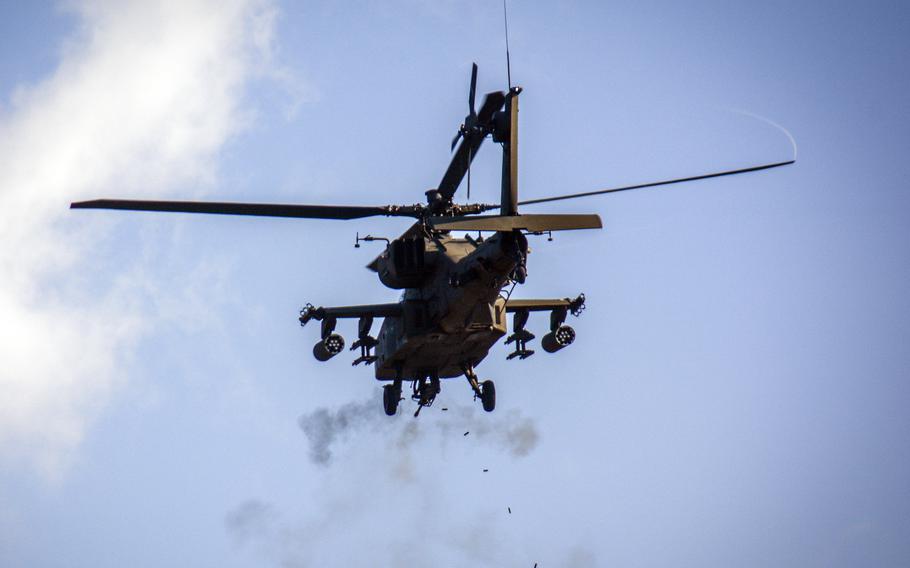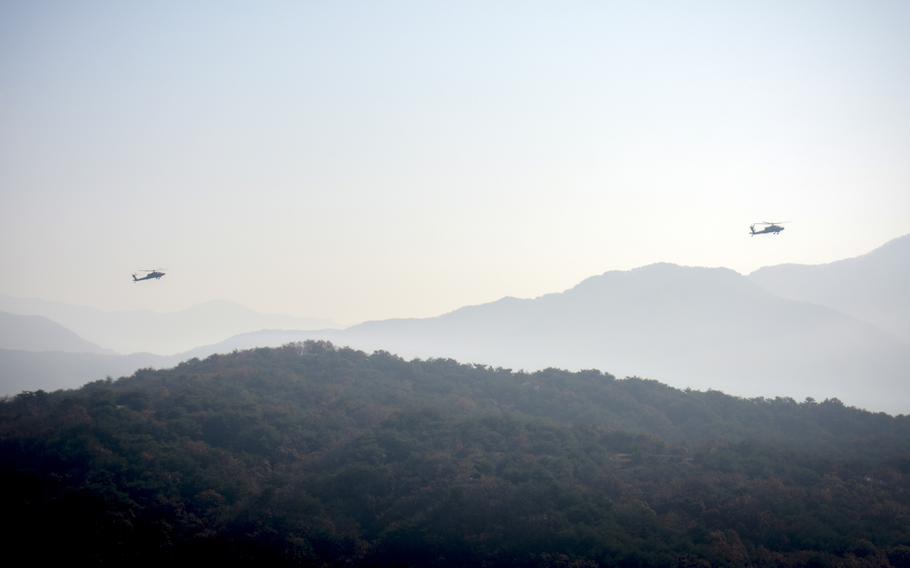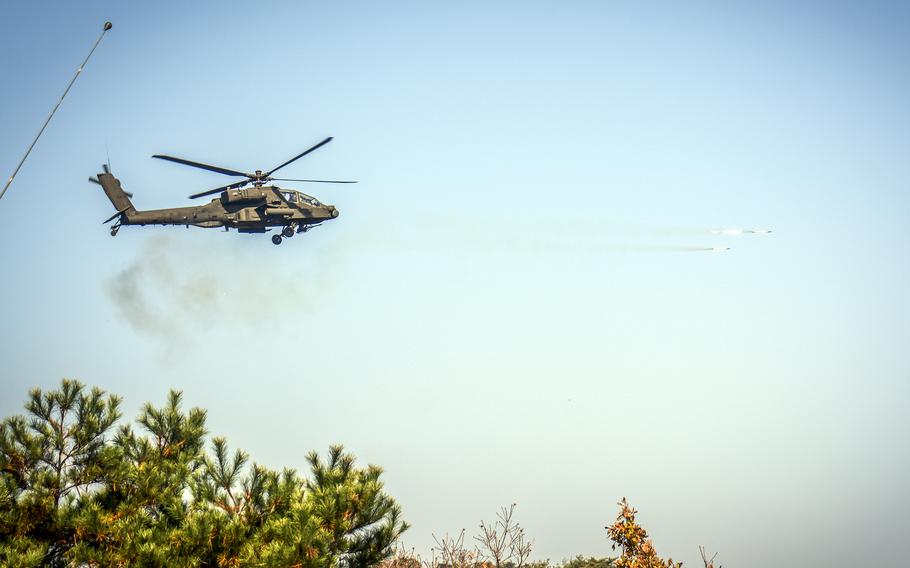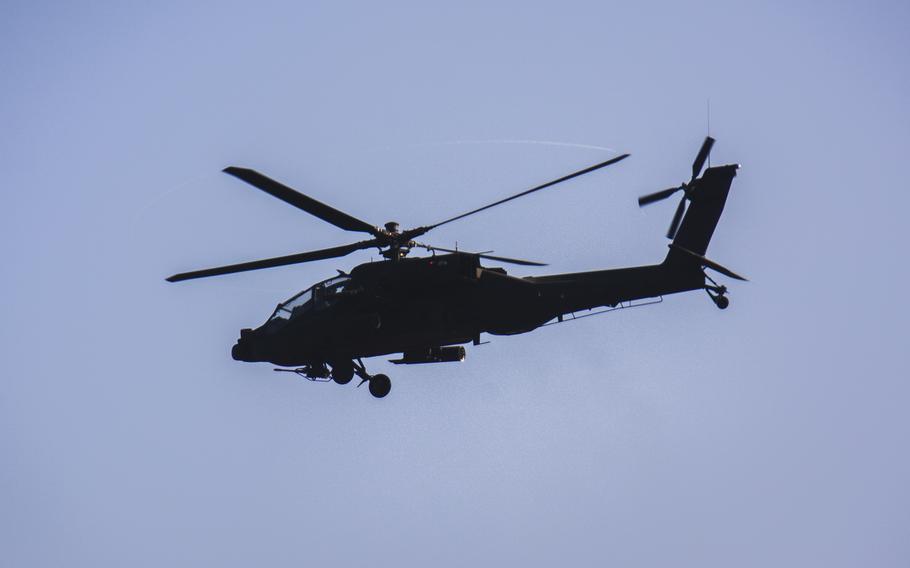
A U.S. Army AH-64 Apache fires a mounted machine gun over Rodriguez Live Fire Complex near Pocheon, South Korea, on Oct. 30, 2024. (Luis Garcia/Stars and Stripes)
RODRIGUEZ LIVE FIRE COMPLEX, South Korea — Choking clouds of dust and debris swirled this week as two Apache helicopter gunships, armed and ready, circled above this firing range 16 miles from the Demilitarized Zone.
One gunship moved into a firing position Wednesday and fired short bursts from its chin-mounted, 30 mm automatic chain gun, the rounds piercing simple targets below. It followed with longer bursts, let fly some 27.5-inch folding fin missiles and then looped around for a final gun run before departing the range.
“The primary objective of our training here is to qualify our Apache crews for aerial gunnery,” Lt. Col. Brian Silva, commander of 5th Squadron, 17th Air Cavalry Regiment, said Wednesday at the range. “We’re focusing on the skills of our individual pilots to identify, engage and destroy targets.”
U.S. and South Korean attack helicopters were letting loose two weeks after an agreement over live-fire exercises at the Rodriguez Live Fire Complex was reached by the South Korean Ministry of National Defense, the South Korean army and a local citizens group unhappy with the noise of live-fire training.

U.S. Army AH-64 Apaches fly over the Rodriguez Live Fire Complex near Pocheon, South Korea, on Oct. 30, 2024. (Eric Mendiola/Stars and Stripes)
The Apaches resumed live-fire training last year following a six-year ban on those drills because of noise concerns. The August agreement “normalized” the live-fire training schedule, according to the ministry at the time.
Hundreds of troops from both countries took part in drills this week focused on tactical teamwork and readiness, Col. Juan Martinez, a spokesman for 8th Army, said Wednesday at the range. Training on the ground and in the air allowed the two militaries to work together near the DMZ, he said.
The Apaches took center stage Wednesday. The AH-60 Apache Longbow is the U.S. Army’s go-to weapon in the air. The twin-engine, multi-mission helicopter carries a pilot and gunner and can haul 27.5-inch folding fin and Hellfire missiles to the battlefield, along with a 30 mm automatic chain gun mounted on its chin.
Its suite of avionics can link the gunship with Bradley and Stryker fighting vehicles and other battlefield partners for information sharing and targeting.

A U.S. Army AH-64 Apache shoots a rocket over the Rodriguez Live Fire Complex near Pocheon, South Korea, on Oct. 30, 2024. (Luis Garcia/Stars and Stripes)
The exercise served also to certify U.S. platoons to operate alongside South Korean troops.
Working directly with South Korean forces provides essential insights for U.S. soldiers, Spc. Augustus Baumann, a fire support specialist with the 2nd Infantry Division, said Wednesday at the Rodriguez complex.
“Seeing how the Koreans conduct business … if an actual war happens, those are the people we’re going to be working with,” he said.
The hands-on experience of a live-fire exercise opens a new understanding of joint operations, Baumann said.
“It’s no longer something you’re seeing on a slideshow; no one’s telling you how it’s supposed to happen,” he said.

A U.S. Army AH-64 Apache flies over the Rodriguez Live Fire Complex near Pocheon, South Korea, on Oct. 30, 2024. (Luis Garcia/Stars and Stripes)
The Rodriguez Live Fire Complex has been more active recently, thanks to new agreements like the one reached Oct. 15 that allow broader live-fire drills, Martinez said. The complex is a key spot for joint military training.
The South Korean and the U.S. armies both fly Apaches, for example.
“We both use the same equipment, so it makes us very good teammates,” Silva said.
Armored U.S. Strykers and South Korean K1A2 tanks are also running joint ground operations, he said. In addition to air support from the Apaches and A-10 Warthog fixed-wing attack aircraft came artillery fire from U.S. M777 and South Korean K-9 howitzers.
“Sometimes people misunderstand or misrepresent the value of the range,” Martinez said. “This range brings a lot of value not only to the U.S. forces but to the Korean forces. The readiness of the peninsula — this is like the No. 1 spot.”